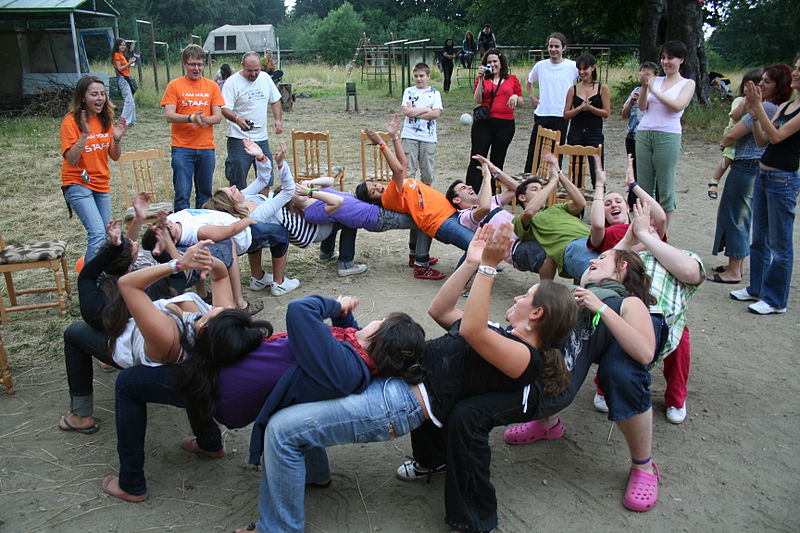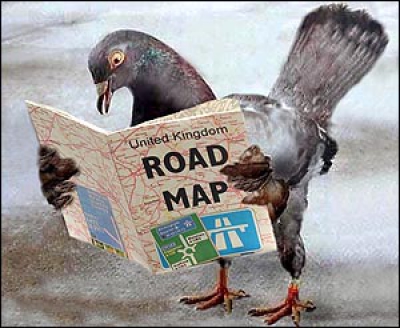Archive for the ‘Fear’ Category
The Confusing Antimatter of Novelty
In a confusing way, the seemingly negative elements of novelty are actually tell-tale signs you’re doing it right. Here are some examples:
No uncertainty, no upside.
No heresy, no game-changer.
No recipe, no worries.
No ambiguity, no new markets.
No effectiveness, no success.
No efficiency, no matter.
No disagreement, no gravity.
No answers, no problem.
No problem, no innovation.
No dispute, no dilemma.
No headache, no quandary.
No obstacle, no predicament.
No unrest, no virtue.
No failure, no creativity.
No discomfort, no relevance.
No agitation, no consequence.
No questions, no significance.
No best practice, no anxiety.
No downside, no upside.
Define To Solve
 Countries want their companies to create wealth and jobs, and to do it they want them to design products, make those products within their borders, and sell the products for more than the cost to make them. It’s a simple and sustainable recipe which makes for a highly competitive landscape, and it’s this competition that fuels innovation.
Countries want their companies to create wealth and jobs, and to do it they want them to design products, make those products within their borders, and sell the products for more than the cost to make them. It’s a simple and sustainable recipe which makes for a highly competitive landscape, and it’s this competition that fuels innovation.
When companies do innovation they convert ideas into products which they make (jobs) and sell (wealth). But for innovation, not any old idea will do; innovation is about ideas that create novel and useful functionality. And standing squarely between ideas and commercialization are tough problems that must be solved. Solve them and products do new things (or do them better), become smaller, lighter, or faster, and people buy them (wealth).
But here’s the part to remember – problems are the precursor to innovation.
Before there can be an innovation you must have a problem. Before you develop new materials, you must have problems with your existing ones; before your new products do things better, you must have a problem with today’s; before your products are miniaturized, your existing ones must be too big. But problems aren’t acknowledged for their high station.
There are problems with problems – there’s an atmosphere of negativity around them, and you don’t like to admit you have them. And there’s power in problems – implicit in them are the need for change and consequence for inaction. But problems can be more powerful if you link them tightly and explicitly to innovation. If you do, problem solving becomes a far more popular sport, which, in turn, improves your problem solving ability.
But the best thing you can do to improve your problem solving is to spend more time doing problem definition. But for innovation not any old problem definition will. Innovation requires level 5 problem definition where you take the time to define problems narrowly and deeply, to define them between just two things, to define when and where problems occur, to define them with sketches and cartoons to eliminate words, and to dig for physical mechanisms.
With the deep dive of level 5 you avoid digging in the wrong dirt and solving the wrong problem because it pinpoints the problem in space and time and explicitly calls out its mechanism. Level 5 problem definition doesn’t define the problem, it defines the solution.
It’s not glamorous, it’s not popular, and it’s difficult, but this deep, mechanism-based problem definition, where the problem is confined tightly in space and time, is the most important thing you can do to improve innovation.
With level 5 problem definition you can transform your company’s profitability and your country’s economy. It does not get any more relevant than that.
The Invisible Rut of Success
It’s easier to spot when it’s a rut of failure – product costs too high, product function is too low, and the feeding frenzy where your competitors eat your profits for lunch. Easy, yes, but still possible to miss, especially when everyone’s super busy cranking out heaps of the same old stuff in the same old way, and demonstrating massive amounts of activity without making any real progress. It’s like treading water – lots of activity to keep your head above water, but without the realization you’re just churning in the same place.
But far more difficult to see (and far more dangerous) is the invisible rut of success, where cranking out the same old stuff in the same old way is lauded. Simply put – there’s no visible reason to change. More strongly put, when locked in this invisible rut newness is shunned and newness makers are ostracized. In short, there’s a huge disincentive to change and immense pressure to deepen the rut.
To see the invisible run requires the help of an outsider, an experienced field guide who can interpret the telltale signs of the rut and help you see it for what it is. For engineering, the rut looks like cranking out derivative products that reuse the tired recipes from the previous generations; it looks like using the same old materials in the same old ways; like running the same old analyses with the same old tools; all-the-while with increasing sales and praise for improved engineering productivity.
And once your trusted engineering outsider helps you see your rut for what it is, it’s time to figure out how to pull your engineering wagon out of the deep rut of success. And with your new plan in hand, it’s finally time to point your engineering wagon in a new direction. The good news – you’re no longer in a rut and can choose a new course heading; the bad news – you’re no longer in a rut so you must choose one.
It’s difficult to see your current success as the limiting factor to your future success, and once recognized it’s difficult to pull yourself out of your rut and set a new direction. One bit of advice – get help from a trusted outsider. And who can you trust? You can trust someone who has already pulled themselves out of their invisible rut of success.
Own Your Happiness
 Own your ideas, not the drama.
Own your ideas, not the drama.
Own your words, not the gossip.
Own your vision, not the dogma.
Own your effort, not the heckling.
Own your vacation, not the email.
Own your behavior, not the strife.
Own your talent, not the cynicism.
Own your deeds, not the rhetoric.
Own your caring, not the criticism.
Own your sincerity, not the hot air.
Own your actions, not the response.
Own your insights, not the rejection.
Own your originality, not the critique.
Own your passion, not the nay saying.
Own your loneliness, not the back story.
Own your health, not the irrational workload.
Own your thinking, not the misunderstanding.
Own your stress level, not the arbitrary due date.
Own your happiness.
Build A Legacy Of Trust
 We set visions, define idealized future states, define metrics, and create tools and processes to realize them. It’s all knit together, the puzzle pieces fight tightly, and it leaves out the most important part – people and their behavior.
We set visions, define idealized future states, define metrics, and create tools and processes to realize them. It’s all knit together, the puzzle pieces fight tightly, and it leaves out the most important part – people and their behavior.
Metrics represent the all-important output of our tools and processes, and we’re so fascinated by metrics because customers pay for outputs they stand for. The output of the product development process is the recipe for the product, and the output of the manufacturing process is product itself. We’re muscle bound with metrics because these outputs are vitally important to profitability. Here’s a rule: the processes and tools we deem most important have the most metrics.
Metrics measure outputs, and managing with output metrics is like driving a car while looking in the rear view mirror. But that’s what we do. But what about managing the inputs?
The inputs to tools are people and their behaviors. People use tools, and how they use them – their behavior – governs the goodness of the output. Sometimes we behave otherwise, but how people use the tools (the inputs) is more important than the tools. But don’t confuse the sequence of steps with behaviors.
All the steps can be intricately defined without capturing the desired behavior. 1.) Load the solid model – see Appendix C. 2.) Set up the boundary conditions using the complicated flow chart in Appendix D. 3.) Run the analysis. 4.) Interpret the results. (Which is far too complicated to capture even in the most complicated appendix.) But the steps don’t define the desired behavior. What’s the desired behavior if the flowchart doesn’t come up with boundary conditions that are appropriate? What’s the behavior to decide if they’re inappropriate? What’s the behavior if you’re not sure the results are valid? What’s the behavior to decide if an analysis is needed at all?
The desired behaviors could go something like this: If the boundary conditions don’t make sense, trust your judgment and figure out why it doesn’t make sense. Don’t spend all day, but use good judgment on how long to spend. If you’re still not sure, go ask someone you trust. Oh, and if you think an analysis isn’t needed, trust your judgment and don’t do one.
And it’s the same for processes – a sequence of steps, even the most complete definition, doesn’t capture the desired behavior when judgment is required.
To foster the desired behavior, people must feel they can be trusted – trusted to use their best judgment. But for people to feel trusted, they have to be trusted. And not trusted once, or once in a while, consistently trusted over time.
Computers and their software tools quickly predictably crank through millions of ultra-defined process steps. But when their processes require judgment, even their hyper-speed can’t save them. When things don’t fit, when it hasn’t been done before, when previous success no longer applies, it’s people and their judgment that must carry the day.
Everyone has the same computers and the same software tools – there’s little differentiation there. People are the big differentiators. And there’s a huge competitive advantage for those companies that create the culture where their people error on the side of exercising their judgment. And for that, you have to build a legacy of trust.
Seeking Comfort in Discomfort
 There’s a natural desire to create comfort because, well, it’s comfortable. The parents of comfort are sameness and familiarity. To be comfortable we naturally seek out familiarity, and since we’re most familiar with what we did last time, we naturally want to repeat the past. Because we’re familiar with it and because the familiarity makes us comfortable, there’s natural gravitational pull toward the past. Same goes for sameness – it’s comfortable so we seek it out. That’s why there’s so much momentum around what we did last time – familiarity and sameness create comfort and comfort feels comfortable.
There’s a natural desire to create comfort because, well, it’s comfortable. The parents of comfort are sameness and familiarity. To be comfortable we naturally seek out familiarity, and since we’re most familiar with what we did last time, we naturally want to repeat the past. Because we’re familiar with it and because the familiarity makes us comfortable, there’s natural gravitational pull toward the past. Same goes for sameness – it’s comfortable so we seek it out. That’s why there’s so much momentum around what we did last time – familiarity and sameness create comfort and comfort feels comfortable.
And there’s a second level of intellectual inertia created by our desire for comfort. Yes, the parents are the same – sameness and familiarity – but this level of comfort is about comfort with what we have. Whatever success we’ve had, we want to hold onto it so we can feel comfortable. It’s the success we know, it’s what we’re familiar with, and we want sameness around success.
Level one is about comfort around our behavior and level two is about comfort around outcomes of our behavior. We do what we did last time because we know how to do it and we extrapolate – because we did it well last time we’ll do it well this time. We do what we did last time because it worked and we extrapolate – because it worked last time it will work well again. And when the past is repeated, we’ll be comfortable.
This is a fine way to go if things are static – when the rules of the past are the same in the future. But the wheels fall off when things are dynamic – extrapolation doesn’t work when the rules change,and surely we live in dynamic times. If there’s one thing we should be uncomfortable with it’s seeking comfort in familiarity and sameness.
Just as comfort fosters sameness, discomfort drives disruption.
No doubt the future’s rules will be different, and discomfort will be the forcing function. Discomfort with the status quo will propel upstarts to innovate and break rules. For them familiarity and sameness are uncomfortable, and since they too are human, they will seek out comfort. But they will find it in unfamiliarity and difference. They will be comfortable when they disrupt the game, dethrone the leaders, and coronate themselves.
Whether you’re the leader or the start-up, increase your level of discomfort. The leader can create pockets of discomfort (financed by comfort-based success) to break the rules on their own terms and obsolete their best stuff on their own timeline. And the already uncomfortable start-up can add more to harden itself for the tough times ahead.
Maximizing comfort does not maximize business success. There is little learning without discomfort and there is no adaptation without it. If you’re feeling comfortable, that’s the telltale sign you shouldn’t.
The Flux Lines of Innovation
 There are countless books, tools, processes, methodologies and frameworks for innovation.
There are countless books, tools, processes, methodologies and frameworks for innovation.
And cutting across all theory and practice, the biggest fundamental of innovation is fear.
We define fear as bad because it limits new thinking and new actions, but there’s another way to look at it. We should look at fear as a leading indicator of innovation potential.
When inputs, outputs, or contexts are different than expectations, our bodies create physical symptoms we recognize as fear. It’s this chemical change in the body, manifested as cold sweats, tingling hands, difficulty in breathing, or knotted stomachs, that’s the tell-tale sign innovation is in the house.
If things are predictable, knowable, understandable, there is no fear. And if things are predictable, knowable, understandable there is no innovation. By the associative theorem: no fear, no innovation.
We should learn to use our bodies as innovation barometers. When pressure builds, especially when we don’t know why, we should recognize our fear, not as a blocker of innovation, but as a leading indicator of it.
Innovation, especially the type that reinvents, is not an in-the-head thing, it’s an in-the-chest thing. It’s indescribable, un-scriptable, and almost spiritual. Just as migratory birds sense weak magnetic fields to guide themselves home, we can use our bodies to sense fear and guide ourselves along the flux lines of innovation.
Fear is scary and can be uncomfortable. But for innovation, it’s scarier if there’s no fear.
Wrestle Your Success To The Ground
 Innovation, as a word, has become too big for its own good, and, as a word, is almost useless. Sure, it can be used to enable magical reinvention of business models and revolutionary products and technologies, but it can also be used to rationalize the rehash work we were going to do anyway. The words that send angry chills down the back of the would-be-innovative company – “We’re already doing it.”
Innovation, as a word, has become too big for its own good, and, as a word, is almost useless. Sure, it can be used to enable magical reinvention of business models and revolutionary products and technologies, but it can also be used to rationalize the rehash work we were going to do anyway. The words that send angry chills down the back of the would-be-innovative company – “We’re already doing it.”
When company leaders talk about doing more innovation, there’s a lot of pressure in the organization to point to innovative things already being done. The organization misinterprets the desire for more innovation as a negative commentary on their work. The mental dialog goes like this – We’re good at our work, we’re working as hard as we can, and we’re doing all we can to meet objectives – hey, look at this innovative stuff we’re doing. Clearly this isn’t what company leaders are looking for, but the word does have that influence.
What can feel better is to describe what is meant by innovation. Wherever we are, whatever successes we’ve had, we want to change our behaviors to create new, more profitable business models; create new products and technologies that obsolete our best, most profitable ones; and change our behaviors to create new, more profitable markets. The key is to acknowledge that our existing behaviors are the very thing that has created our success (and thank them for it), and to acknowledge the desire to build on our success by obsoleting it. When we ask for more innovation, we’re asking for new behaviors to dismantle our current day success behind us to create the next level of success.
There’s a tight link to innovation and failure – risk, learning, experimentation – but there’s a missing link with success. Acknowledgement of success helps the organization retain its self worth and helps them feel good about trying new stuff. However, even still, success is huge deterrent to innovation. Company success will retain the behaviors that created it, and more strongly, as new behaviors are injected, the antibodies of success will reject them. Our strength becomes our weakness.
Strong technologies become anchors to themselves; successful, stable, long-running markets hold tightly to resources that created them; and time-tested business models are above the law. New behaviors almost don’t stand a chance.
Fear of losing what we have is the number one innovation blocker. Where failure blocks innovation narrowly in the blast zone, success smears a thick layer of inaction across the organization. What’s most insidious, since we celebrate success, since we laud customer focus, since we track and reward efficiently doing what we’ve done, we systematically thicken and stiffen the layer that gums up innovation.
Instead of starting with a call-to-arms for innovation, it’s best to define company values, mission, and strategic objectives. Then, and only then, define innovation as the way to get there. First company objectives, then innovation as the path.
Innovation, as a word, isn’t important. What’s important are the new behaviors that will wrestle success to the ground, and pin it.
What They Didn’t Teach Me in Engineering School
 The technical stuff is the easy part. Technical systems respond predictably, but people don’t.
The technical stuff is the easy part. Technical systems respond predictably, but people don’t.
There’s nothing worse than solving the wrong problem, so before you start solving you’ve better done a whole lot of defining.
There is no exact answer; engineering is all about judgment.
Organizational structure is important. Whatever the structure, see its strengths and make them work for you. If you try to fight it, it will eat you.
Innovation isn’t about ideas, innovation is about commercializing ideas.
Engineering analysis can win minds, but not hearts. And hearts govern minds.
The engineer’s role is not to minimize risk; it’s to understand the commercial reward and take risk accordingly.
What people believe is far more powerful than what they think.
New technology threatens status quoers, and, in turn, they block it.
There is no problem unless someone important thinks there’s one.
All technical systems are really human systems masquerading as technical systems.
If you let it, fear dominates. Be afraid and do it anyway. But along the way, keep in mind that others are too afraid to try.
Engineering is not sane and rational; engineering is about people.
A Healthy Dissatisfaction With Success
 They say job satisfaction is important for productivity and quality. The thinking goes something like this: A happy worker is a productive one, and a satisfied worker does good work. This may be true, but it’s not always the best way.
They say job satisfaction is important for productivity and quality. The thinking goes something like this: A happy worker is a productive one, and a satisfied worker does good work. This may be true, but it’s not always the best way.
I think we may be better served by a therapeutic dose of job dissatisfaction. Though there are many strains of job satisfaction, the most beneficial one spawns from a healthy dissatisfaction with our success. The tell-tale symptom of dissatisfaction is loneliness, and the invasive bacterium is misunderstanding. When the disease is progressing well, people feel lonely because they’re misunderstood.
Recycled ideas are well understood; company dogma is well understood; ideas that have created success are well understood. In order to be misunderstood, there must be new ideas, ideas that are different. Different ideas don’t fit existing diagnoses and create misunderstanding which festers into loneliness. In contrast, when groupthink is the disease there is no loneliness because there are no new ideas.
For those that believe last year’s ideas are good enough, different ideas are not to be celebrated. But for those that believe otherwise, new ideas are vital, different is to be celebrated, and loneliness is an important precursor to innovation.
Yes, new ideas can grow misunderstanding, but misunderstanding on its own cannot grow loneliness. Loneliness is fueled by caring, and without it the helpful strain of loneliness cannot grow. Caring for a better future, caring for company longevity, caring for a better way – each can create the conditions for loneliness to grow.
When loneliness is the symptom, the prognosis is good. The loneliness means the organization has new ideas; it means the ideas are so good people are willing to endure personal suffering to make them a reality; and, most importantly, it means people care deeply about the company and its long term success.
I urge you to keep your eye out for the markers that define the helpful strain of loneliness. And when you spot it, I hope you will care enough to dig in a little. I urge you think of this loneliness as the genes of a potentially game-changing idea. When ideas are powerful enough to grow loneliness, they’re powerful enough to move from evolutionary into revolutionary.
How long will it take?
 How long will it take? The short answer – same as last time. How long do we want it to take? That’s a different question altogether.
How long will it take? The short answer – same as last time. How long do we want it to take? That’s a different question altogether.
If the last project took a year, so will the next one. Even if you want it to take six months, it will take a year. Unless, there’s a good reason it will be different. (And no, the simple fact you want it to take six months is not a good enough reason in itself.)
Some good reasons it will take longer than last time: more work, more newness, less reuse, more risk, and fewer resources. Some good reasons why it will go faster: less work, less newness, more reuse, less risk, more resources. Seems pretty tight and buttoned-up, but things aren’t that straight forward.
With resources, the core resources are usually under control. It’s the shared resources that are the problem. With resources under their control (core resources) project teams typically do a good job – assign dedicated resources and get out of the way. Shared resources are named that way because they support multiple projects, and this is the problem. Shared resources create coupling among projects, and when one project runs long, resource backlogs ripple through the other projects. And it gets worse. The projects backlogged by the initial ripple splash back and reflect ripples back at each other. Understand the shared resources, and you understand a fundamental dynamic of all your projects.
Plain and simple – work content governs project timelines. And going forward I propose we never again ask “How long will it take?” and instead ask “How is the work content different than last time?” To estimate how long it will take, set up a short face-to-face meeting with the person who did it last time, and ask them how long it will take. Write it down, because that’s the best estimate of how long it will take.
It may be the best estimate, but it may not be a good one. The problem is uncertainty around newness. Two important questions to calibrate uncertainty: 1) How big of a stretch are you asking for? and 2) How much do you know about how you’ll get there? The first question drives focus, but it’s not always a good predictor of uncertainty. Even seemingly small stretches can create huge problems. (A project that requires a 0.01% increase in the speed of light will be a long one.) What matters is if you can get there.
To start, use your best judgment to estimate the uncertainty, but as quickly as you can, put together a rude and crude experimental plan to reduce it. As fast as you can execute the experimental plan, and let the test results tell you if you can get there. If you can’t get there on the bench, you can’t get there, and you should work on a different project until you can.
The best way to understand how long a project will take is to understand the work content. And the most important work content to understand is the new work content. Choose several of your best people and ask them to run fast and focused experiments around the newness. Then, instead of asking them how long it will take, look at the test results and decide for yourself.

 Mike Shipulski
Mike Shipulski